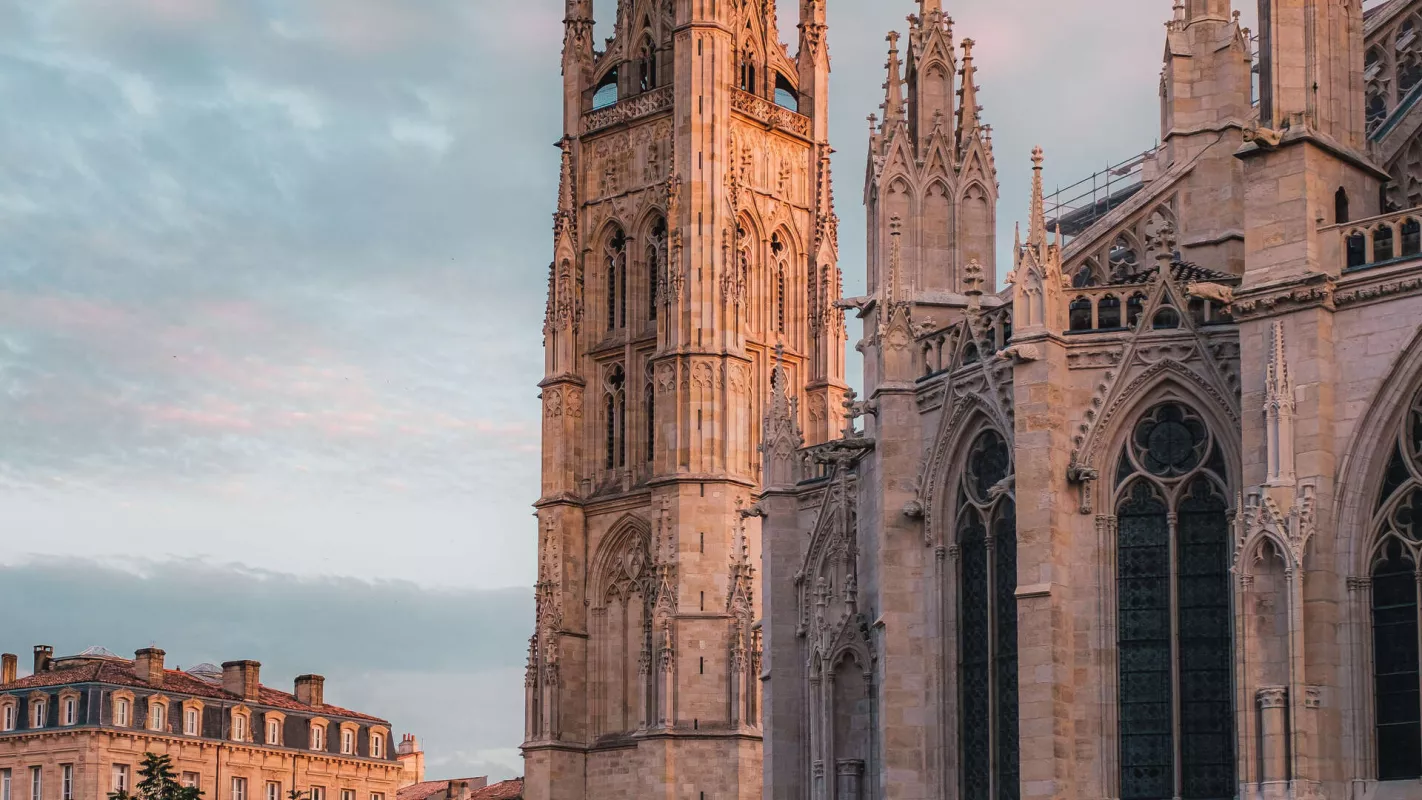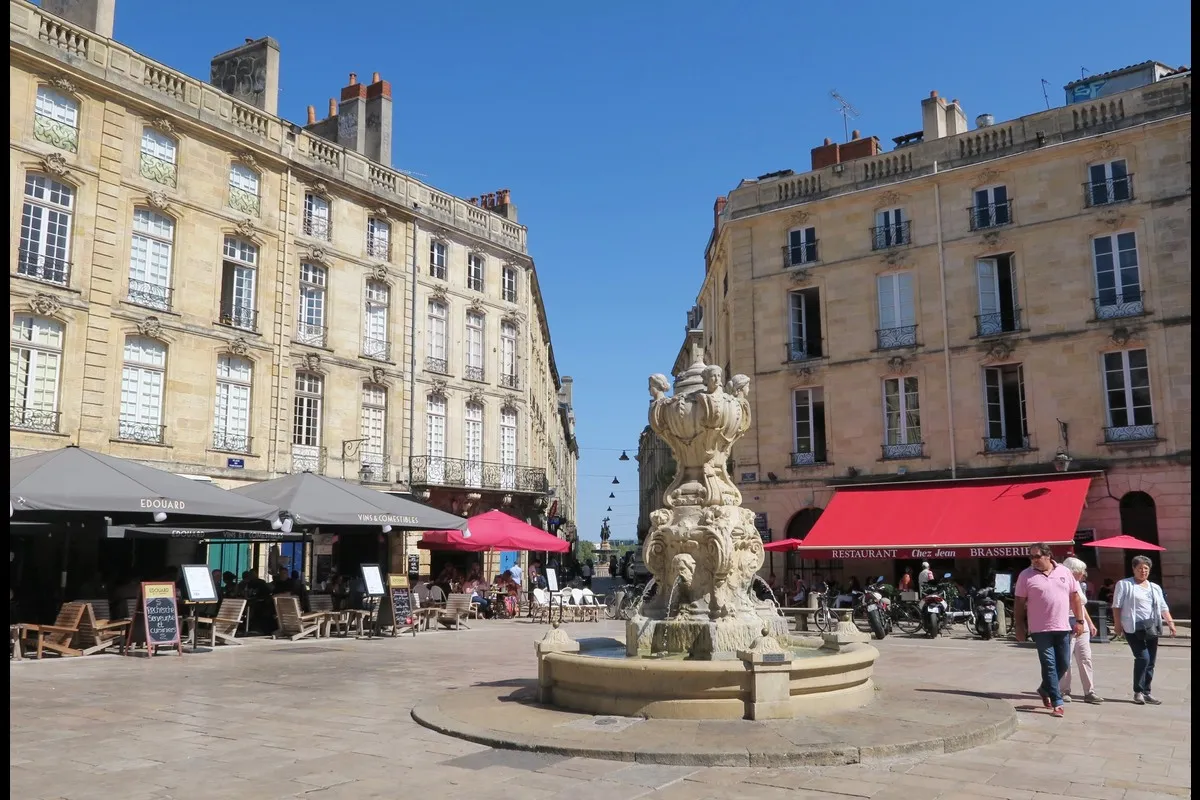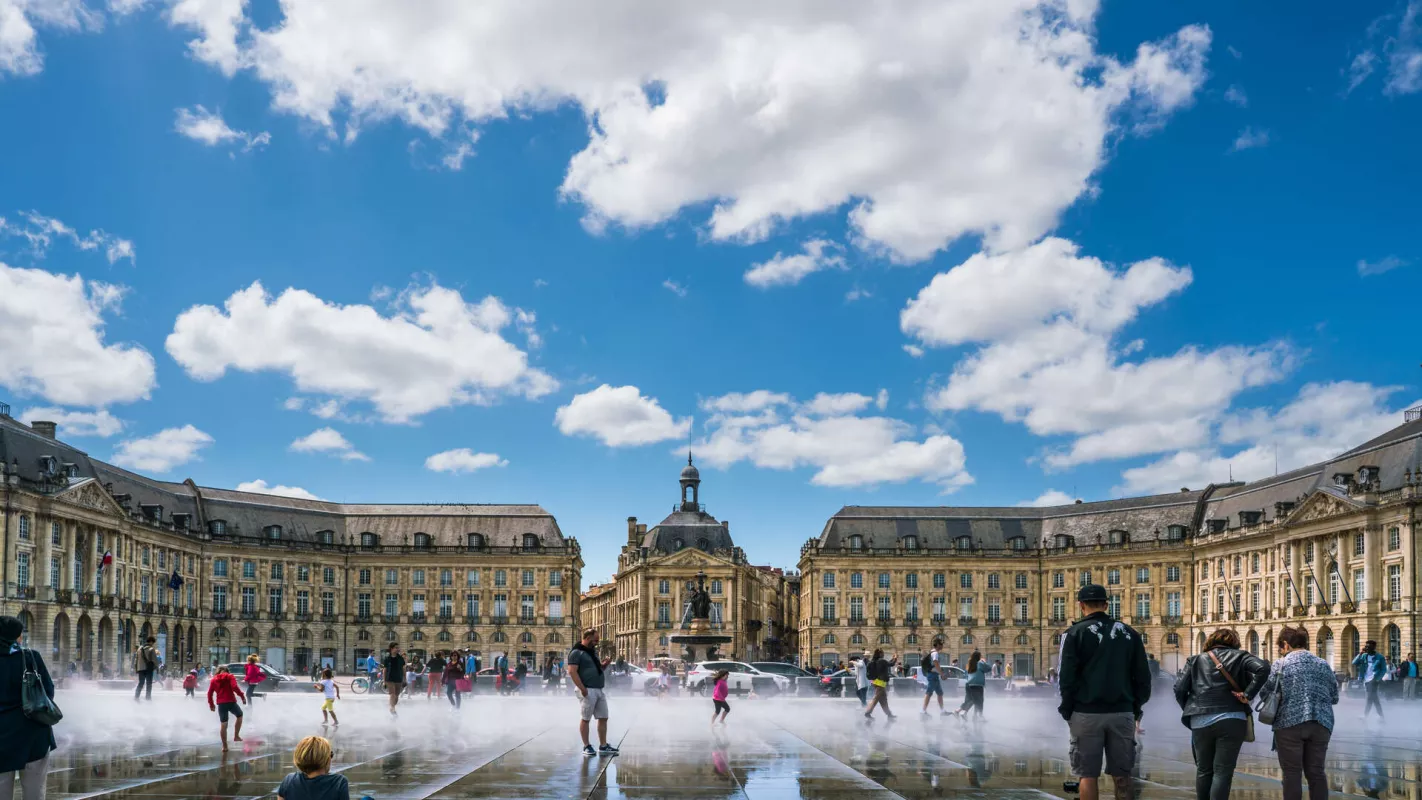.jpgcde1.webp)
Walking through UNESCO-listed Bordeaux
Bordeaux cuts a fine figure, as evidenced by the city’s classical and neoclassical architecture, which has dazzled for over two centuries. It was in recognition of the value and unity of the Gironde capital’s 18th-century heritage that Bordeaux was awarded a place on UNESCO’s prestigious World Heritage List in 2007. Far from resting on its laurels, the city has kept up this momentum through the urban project initiated in 1996 by the former mayor, Alain Juppé. Since then, the metropolis has undergone a transformation, revealing its charms for all to see.
Today, Bordeaux is home to more than 350 structures that are nationally or regionally listed Historical Monuments (Monuments Historiques), including three religious ensembles that have been World Heritage sites since 1998, listed in the Routes of Santiago de Compostela category. Bordeaux’s originality in this respect is shown through the size of the UNESCO-listed perimeter: 1810 hectares in total, which equates to almost half of the city’s surface area. Moreover, the entirety of the city of Bordeaux, including the zones that stretch beyond the “les boulevards” (the inner city ring-road) and eight adjoining communes form part of a zone whose heritage is officially recognised as “of cultural significance”.
Follow the bronze markers that make up our designated route and explore Bordeaux from top to bottom. Throughout this itinerary, act as your own guide as you take in the sumptuous private mansions, impressive residences, monumental gateways and architecturally harmonious facades, which together prove the breadth of the great designs of Intendant Tourny and his successors. Off you go!
The Port de la Lune route has been awarded a disability label ("Tourisme et Handicap"), and the itinerary is available online or in brochure form from the tourist office.
- For more visits and savings, don’t set off without the essential city pass!
- Would you like to explore the historic heart of Bordeaux in the company of one of our guides? Find all our guided tours on visiter-bordeaux
BORDEAUX: A MONUMENTAL ENDEAVOUR
This monument reaches 43 metres into the air, lording over the largest square in Europe. Despite its name, the Monument aux Girondins was not erected to commemorate the famous Bordeaux-based football team! Built between 1894 and 1902, it pays homage to the members of the Girondins political faction who fell victim to the Reign of Terror. Visible from several points across the city, at the column’s summit sits a statue of Liberty breaking her chains. At the base of the column there are more bronze sculptures and ornamental fountains that produce a refreshing spray on warm days. Listed as a historical monument in 2011, it is one of the most photographed spots in Bordeaux.
When you look at this former private mansion, just a few metres from Quinconces, does its shape remind you of another famous building? Designed by architect Victor Louis and built in 1789, the building is shaped like the stem of a boat, as if it were greeting the ocean, close by. If you have been to New York, you will no doubt notice a similarity with the renowned Flatiron Building. An established Bordeaux institution, in its past it has played host to a cinema and was Citroen’s first branch in the city. Since 1948, it has been home to the Bordeaux Wine Council (Le Conseil Interprofessionnel du Vin de Bordeaux) and their wine bar on the third floor.
A stone’s throw from Maison Gobineau, the Grand Théâtre once again demonstrates the brilliance of the architect Victor Louis. This temple to the performing arts was inaugurated in 1790, and is just as majestic on the inside as on the outside. The building became a listed historical monument in 1899, and is today the seat of the Bordeaux National Opera (L’Opéra national de Bordeaux). Look to the top of the portico and admire the twelve stone statues depicting 9 muses and 3 goddesses: Minerva, Venus and Juno. Such sumptuous decoration gives you a taste of what to expect beyond its doors; enter and you will be treated to a superb grand staircase, which was an inspiration for the architect of the Garnier opera house in Paris.
Your journey continues a short walk away to Place du Chapelet where you’ll be greeted by the Church of Notre Dame (L’Église Notre-Dame), previously dedicated to Saint-Dominic. The church was built in a Baroque style that was typical of the Counter-Reformation and was listed as a historical monument in 1908, as was the casing of its organ in 1971. Notre Dame - the construction of which was completed in 1707 - is remarkably well-preserved today thanks to comprehensive restoration work, carried out in 1982. Making the most of its exceptional acoustics, concerts are regularly hosted here, while the exterior can be regularly seen on film, as the forecourt is often used for filming historical movies.
While this was the site of the western entrance to the city from Roman times onwards, today the arch, Porte Dijeaux, looks out onto the new and improved Place Gambetta. It was built between 1748 and 1753 by Michel Voisin, and went on to bear the name of Porte Dauphine under the reign of Louis XV, in honour of the Dauphin and future King of France, Louis XVI. After the Revolution, it became Porte Dijeaux, sitting at the beginning (or the end) of the street of the same name. This archway is admired all day long by locals and visitors alike, and became a listed historical monument in 1921.
Built between 1771 and 1784, Palais Rohan has hosted many influential people in its luxurious rooms. Initially built as the archbishop’s residence, it went on to become an administrative building in 1791 as the seat of the revolutionary tribunal, then it was made the Gironde prefecture in 1800, subsequently becoming an imperial palace for Napoleon I in 1808 and a royal residence in 1815 under Louis XVIII, before finally assuming the role of Bordeaux’s city hall (La Mairie de Bordeaux) in 1837. Built in the monumental neoclassical style, the palace itself and its main courtyard have been listed as historical monuments since 1997, as have many rooms on the ground floor, its facades and roof work.
Across from Palais Rohan, La Cathédrale Saint-André has also received some illustrious visitors in its time. The list is long, but this place of worship was notably chosen as the site to celebrate two royal weddings: that of Eleanor of Aquitaine and the future Louis VII of France, as well as the union of Anne of Austria and Louis XIII. The cathedral was built in the gothic style between the 12th and 16th centuries, and is home to one of the largest pipe organs in France (15 metres tall), a listed historical monument. A few metres from the forecourt, La Tour Pey Berland is the cathedral’s bell tower, built in the 15th century, reigning over the city at 66 metres tall. Those brave enough to climb its 233 steps to the top are greeted by a unique panorama.
Once upon a time there was Aquitaine, a magnificent region in the south-west of France. To learn all about its history in a fun and interesting way, the Musée d’Aquitaine is the place to visit. On the cusp of the most central part of the city, this museum reveals the history of Bordeaux and its region, from prehistory up until the present. In addition to the permanent collection of 70,000 pieces, temporary exhibitions provide another perspective on what we now call Nouvelle Aquitaine (“New Aquitaine”).
This construction is aptly referred to simply as “the Great Bell”, and the eponymous bell rings out on 6 precise dates every year: 1st May, 8th May, 14th July, 28th August, 11th November and on the first Sunday of every month at midday. In case you were doubting the legitimacy of the name, the aforementioned bell weighs some 7800 kg! It was cast in 1775 and passes its days in the company of a golden lion (the symbol of the Kings of England), which sits atop the tower. Nowadays, the monument is the last remnant of the 13th century defensive gateway that once lay here.
Children playing, laughter emanating from the terraces, lovers entwined on a bench, musicians singing: the atmosphere on Place Fernand Lafargue oozes conviviality and the joys of city living. It is difficult to imagine that, a few centuries ago, a pillory stood here as an instrument of terror. The square was a place of torture, but also one that featured all kinds of commerce. Gradually, stands for fish, meat and other goods replaced instruments of death. Nowadays, it is one of the most popular spots in the city!
We have already seen Porte Dijeaux, now it’s time to get acquainted with its cousin, the beautiful Porte Cailhau! Built between 1493 and 1496, it was the main entrance to the city from the Garonne. Also known as “La Porte du Palais” (“the palace gate”), it also served as a defensive gateway and triumphal arch, dedicated to the glory of Charles VIII, King of France. Indeed, you can still see a stone effigy of his crowned head on the facade. Listed as a historical monument in 1883, visitors can now take a look inside and learn a little more about its history.
Today, Église Saint-Pierre is tucked away in the labyrinth of narrow streets that make up Bordeaux’s Old Town, this religious building was once basically in the water! Built in the 14th and 15th centuries right next to the Devèze river, close to its confluence with the Garonne, this was a port-side church a long time ago. Rebuilt from 1358 onwards, then restructured in 1882, it became a listed historical monument in 1908.
Bordeaux’s geography and history can be navigated through its squares. Place du Parlement whisks you away to Italy with its architecture. The square was created in the Saint Pierre quarter in 1754, and is lined with splendid facades that date from the first half of the 18th century. Its fountain, built in the English neo gothic style, was added in 1865. Like other squares in the city, it has had many different lives. It was created as Place du Marché Royal (“Royal Market Square”) and renamed as Place de la Liberté (“Liberty Square”) during the Revolution, before taking on its current name in homage to the institution that was abolished in 1790. It has been a listed historical monument since 1952.
Here, you’d be forgiven for thinking that you’ve been transported back to the French Enlightenment. If you close your eyes, you can almost hear the sound of horse-drawn carriages on the cobblestones. Welcome to the most famous square in Bordeaux! Built between 1730 and 1755, Place de la Bourse was previously known as Place Royale. Opposite the Garonne, its grand buildings are reflected in the water mirror across the street. It was the first open square in Europe, and today is home to Palais de la Bourse (the Chamber of Commerce), Hôtel des Douanes (the customs house) and the Fountain of the Three Graces (1869) at its centre.
With its 3450 m² surface and 800 m³ underground reservoir, Bordeaux’s Miroir d’Eau (“water mirror”) is the largest water mirror in the world! It was inaugurated in 2006 as one of the the key elements of the redevelopment of the quayside, initiated by Mayor Juppé. Thanks to its views of the Garonne and Place de la Bourse, the Miroir d’Eau has become a symbol of the city and one of the most popular spots for locals and visitors alike.
Points of Interest (POI)
39 Rue Bouffard, 33000 Bordeaux, France
Though this place has its own history, it also has a contemporary eye, presenting works and exhibitions from the world of design. In 2018, its two constituent buildings - a private mansion built under the Ancien Régime and a prison from the 19th century - were listed as historical monuments.
Rue Sainte-Catherine, 33000 Bordeaux
Rue Saint Catherine has been a fully pedestrianised zone since 1984, and cuts through the city centre on a North-South axis, running from the Grand Théâtre on Place de la Comédie to the Theimer Column on Place de la Victoire. Many of the great French brands can be found along here, as well as numerous cafes and small restaurants that provide a welcome break.
1 Place de la Bourse, 33000 Bordeaux
Le Musée national des douanes (“the National Customs Museum”) is located in L’Hôtel des Fermes du Roi: a jewel in Bordeaux’s 18th-century architecture. It sits on Place de la Bourse, a unique quayside square in France. It was originally built to house the precursor to the customs system, La Ferme Générale, which collected taxes for the king. The customs services have occupied the building since La Ferme's demise, over two centuries ago.
33000 Bordeaux
Bordeaux’s riverfront is one of the world’s most magnificent examples of urban heritage, with 18th-century facades, many of which form the front of listed historical monuments. With its greens, parks and gardens that run along the Garonne, the quays are a place for relaxing, shopping and ambling, either on foot or by bike.
7 Rue Ferrere, 33000 Bordeaux
A well-established cultural stakeholder, both nationally and internationally, the CAPC was made an official Musée de France in 2002, and proposes a rich programme of temporary exhibitions and performances throughout the year, as well as a number of cultural and educational events.












%c2%a9mus%c3%a9e%20d_aquitaine.jpg1523.webp)



















